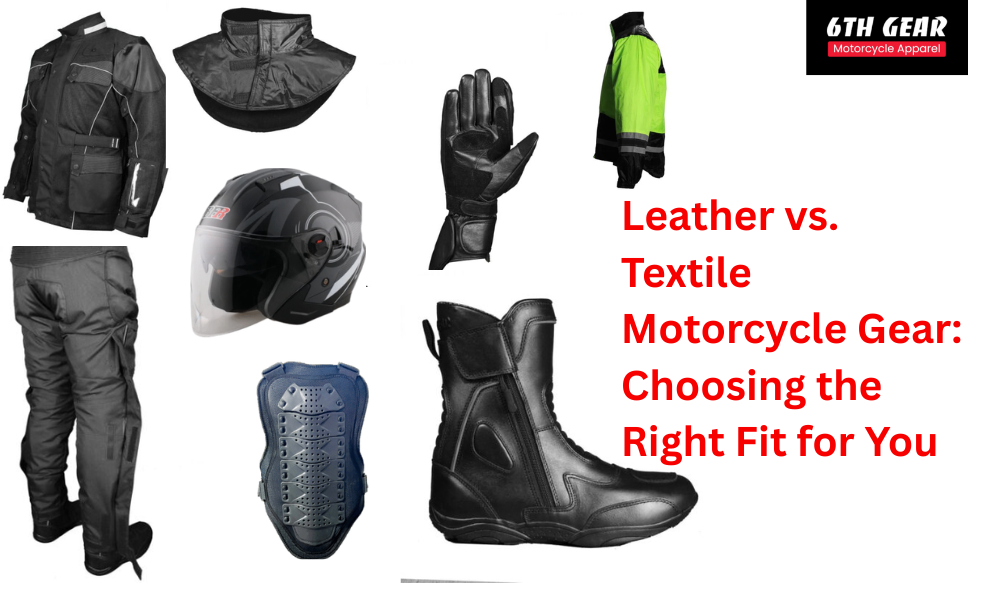Leather vs. Textile Motorcycle Gear: Choosing the Right Fit for You

The leather gear has better abrasion resistance and classic appearance, perfect for high speed adventuring. Textile gear is a weatherproofing, light comfort and multi-purpose thing that is applicable in all-weather conditions and everyday use. Make a choice depending on your riding style and needs.
The discussion on motorcycle gear that never seems to stop raging is leather versus textile. Both have their virtues, their fans, and ideal applications. If you are an experienced rider or a novice, knowing the pros and cons of these materials is very important for making the proper choice for your riding style and needs.
In this blog, we will see the differences in detail and explore their specific features identifying which one will be the most proper for your needs.
What is Motorcycle Gear Made Of?
The materials used to make motorcycle gear come with one thing in mind: protection. Weather gear is usually made from cowhide or goatskin, which provides amazing abrasion and durability. In comparison, textile gear is constructed with state-of-the-art synthetic materials such as Cordura, Kevlar, and Gore-Tex. These fabrics are designed for such things as versatility, weather resistance, and lighter weight.
Leather is a timeless choice that is made out of natural material and forms to the body over time. In the meantime, textiles introduce the latest innovation, offering to all weather riders such options as waterproofing and breathability.
Explore the best riding pants for ultimate comfort and protection on every ride.
Key Differences Between Leather and Textile Gear
Durability and Protection
Leather is famous for its strength even in high speed riding cases. The natural structure of the fiber of leather provides it with better an overall abrasion life, making it ideal for racers and sport riders. Textile gear, despite being durable, is designed to distribute impact well, also often having integrated armour in important places such as shoulders, elbows, and knees.
Weather Resistance
Leather performs great under mild weather; however, it requires constant maintenance to protect against rain. In the absence of treatment, it is capable of absorbing water to cause stiffness and destruction. On the other hand, textile gear has been specifically manufactured for diversified climates. Gore-Tex membranes and other technologies make fabrics waterproof, breathable for comfortable riding in wet weather and long-distance touring.
Comfort and Fit
Leather conforms to the body and becomes comfortable with time, and it yields a second skin for the rider. But, this period for a break-in might not suitably excite everyone. Textile gear provides a more customizable fit right from the beginning, usually using Velcro straps, zippers, and ventilation systems that address the needs of individual users.
Check out our collection of men’s motorcycle pants designed for style, comfort, and protection.
Style Preferences and Aesthetic Appeal
Leather’s traditional, timeless look has established it as motorcycle world standard. Regardless of whatever you are riding, be it a cruiser, café racer or even a comparatively stunted sportbike, leather provides an iconic flair. It’s the pick for the people who prefer a sleek, clean look.
But textile is a canvas for modern creativity. Coming in bright colours, patterns, and reflective edges, it’s a popular choice amongst riders who value visibility and those who want to add an extra kick of personality to their equipment.
Versatility and Use Cases
Every material is best in certain riding conditions. Leather is the best when it comes to track days and highway cruising, in which its abrasion resistance and the sleek fit provide the greatest benefit. Textile gear sparkles for daily commuters, adventure riders, as well as those on different terrains. Its lightweight construction and weatherproofing functionality make it a first choice for longer tours and adverse weather.
Cost and Maintenance
This gear is associated with a high initial cost, but its longevity makes the investment worthwhile. Maintenance such as conditioning and waterproofing needs to be done regularly to maintain leather in a pristine state. Textile gear, in contrast, is less expensive and less demanding as regards its maintenance. Most of the fabric-based items are machine-washable or could be wiped clean, which makes them a reasonable choice for riders on the go.
Discover durable and versatile textile riding pants designed for all-weather performance.
Quick Comparison
| Feature | Leather | Textile |
| Durability | High abrasion resistance | Tear-resistant with armour |
| Weather Resistance | Limited without treatment | Waterproof and breathable |
| Comfort | Snug fit, moulds to the body | Lightweight, adjustable |
| Aesthetic Appeal | Timeless and sleek | Modern and customizable |
| Maintenance | Requires conditioning | Easy to clean |
How to Decide?
Those factors that determine your choice between leather and textile are various:
- Riding Environment: Leather would be a good option if you mostly ride during good weather and on highways. For all-weather conditions, the textile gear is more practical.
- Frequency and Type of Riding: Leather is used for track-day or spirited weekend rides, while for daily commuting and long tour,s the textile suit is the best fit.
- Budget: Remember about the cost of the gear and maintenance.
Hybrid Gear: The Best of Both Worlds
For indecisive riders, the middle ground has been offered by the hybrid gear. Jackets with panels of leather in high impact regions but textile for the flexibility is the optimal balance of protection whilst allowing comfort. These two options are ideal for the riders who wish to enjoy the best of both worlds without one having to make any compromises.
Discover our high-quality leather motorcycle vest, combining iconic style with superior durability.
Conclusion:
The selection between leather and textile motorcycle gear is strictly personal and should be consistent with your riding style, choice, and budget. Both materials have their strengths, and learning the uses of one is a guarantee that you will be ready for the road ahead.
Regardless of whether you decide to go with the age-old durability of leather or with the modern utility of textile, always remember that the most valuable gear is the one that protects you, keeps you comfortable, and makes you feel confident on your voyage.
















